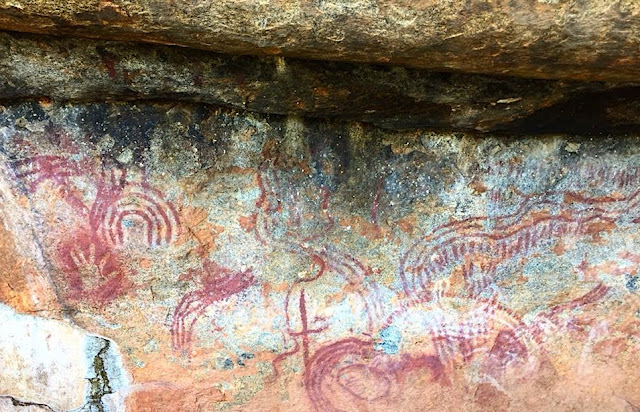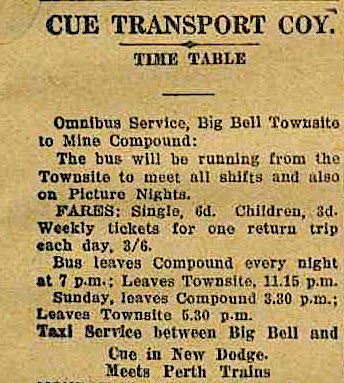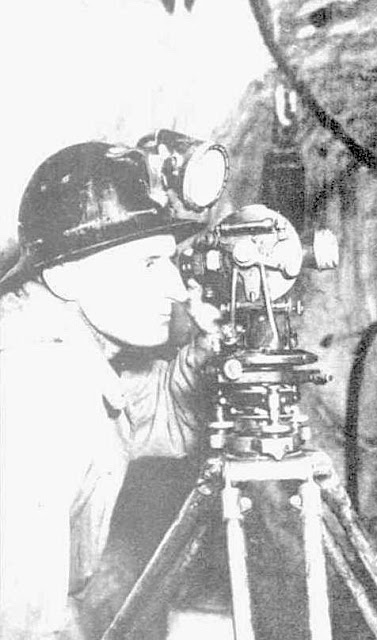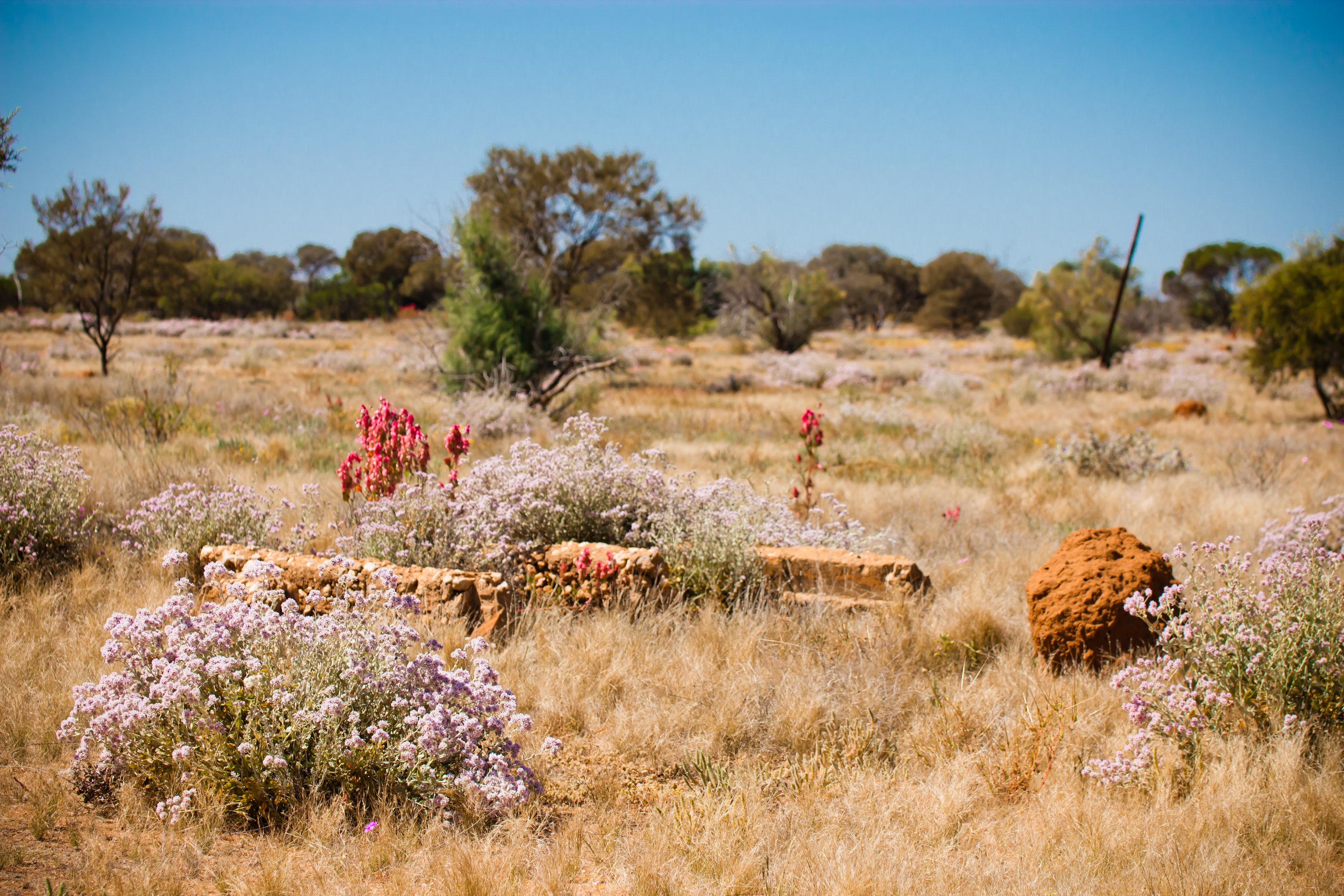According to the Western Mail Newspaper of 1937, the town was gazetted in 1936 and named Townsend; but became known as Big Bell after the mine in the area.
Wadjari People
The area of Big Bell is part of Wadjari territory, where Aboriginal people roamed, hunting and gathering, over a very large area for thousands of years. Knowledge about plants and animals was passed down through the generations, and important skills were developed from early childhood.
Wadjari People
The area of Big Bell is part of Wadjari territory, where Aboriginal people roamed, hunting and gathering, over a very large area for thousands of years. Knowledge about plants and animals was passed down through the generations, and important skills were developed from early childhood.
Just a 30-minute drive from Big Bell, via Cue-Dalgaranga Rd, is Walga Rock (known as Walgahna to the Indigenous people). The rock, which is 1 ½ km long and 5kms around its base, was a meeting place for Aboriginal people.
Supposedly, this rock is the second-largest monolith in Australia, after Uluru. A large gallery of Aboriginal art can be found here of snakes, goannas, spears and also a drawing that is said to be of ships that visited the Western Australian coast in the 17th century, which, according to speculation, may have been made by a shipwrecked Dutch sailor or Afghan camel driver.
Wadjari people speak the southeastern dialect, Kongal-boyal of the Noongar language. In 2012, a 2500-word Wadjari Language Dictionary was launched, which took over 25 years to compile. In the past, this tribe (clan) practised circumcision as a male initiatory rite.
A Wadjari man who spoke to anthropologist Norman Tindale about his people said that the Wadjari, compared to another Aboriginal group, the Widi, "placed great reliance on grass seed food whereas the other people lived only on the hammered seeds of shrubs, did not use the process of wet milling of grass-seed, and ... often went hungry" (Tindale, 1974: 102).
Wadjari people speak the southeastern dialect, Kongal-boyal of the Noongar language. In 2012, a 2500-word Wadjari Language Dictionary was launched, which took over 25 years to compile. In the past, this tribe (clan) practised circumcision as a male initiatory rite.
A Wadjari man who spoke to anthropologist Norman Tindale about his people said that the Wadjari, compared to another Aboriginal group, the Widi, "placed great reliance on grass seed food whereas the other people lived only on the hammered seeds of shrubs, did not use the process of wet milling of grass-seed, and ... often went hungry" (Tindale, 1974: 102).
 |
| Walga Rock, near Cue, Western Australia |
 |
| Aboriginal painting in red ochre on granite walls at Walga Rock near Cue, WA |
 |
| Aboriginal painting in red ochre on granite walls at Walga Rock near Cue, WA |
Herbert Hoover
Herbert Hoover, who was to become the 31st President of the United States of America, arrived in Perth in 1897 to take up a post as a mining engineer. Hoover worked at several mines in Western Australia, including Big Bell. Hoover wrote about his time as a mining engineer in WA in his memoirs.
In 1897 Hoover was in Western Australia as chief of mining staff of Bewick, Moreing and Co., and manager of Hannan's Brown Hill mine; the following year, he was manager of the Sons of Gwalia and East Murchison mines. (1.)
In 1897 Hoover was in Western Australia as chief of mining staff of Bewick, Moreing and Co., and manager of Hannan's Brown Hill mine; the following year, he was manager of the Sons of Gwalia and East Murchison mines. (1.)
 |
| Herbert Hoover, aged 23; taken in Perth, Western Australia, in 1898 |
1904: Gold Found
In 1904, the Big Bell Mine was registered by W. Smith and H. Paton as a reward claim, and given the title of "Paton's Coodardy Reward".
In 1904, the Big Bell Mine was registered by W. Smith and H. Paton as a reward claim, and given the title of "Paton's Coodardy Reward".
The Bell lode produced plenty of gold for several years until WW1.
Then in 1935, the Premier Gold Mining Company announced that they would develop the Big Bell Mine. There was also an agreement with the State Government in March 1936, to build a railway from Cue to the mine leases at Big Bell.
1930s
 |
| Coolgardie Miner (WA : 1935 - 1954), Friday 3 April 1936 |
 |
| Geraldton Guardian and Express (WA : 1929 - 1947), Thursday 23 July 1936 |
The Town Goes Ahead
The Western Mail newspaper in 1937, described the developing town of Big Bell:
Bell townsite was virgin bush - today
there are surveyed streets, roads and a
railway and dozens pf neat residences.
The business section is made up of two
general stores, a hardware store, two
men's outfitters, two combined restaurant
and cool-drink shops (including a milk
bar), a greengrocery, a billiard saloon, a
barber's shop; a newsagency, and an
open-air cinema. A modern brick hotel
is being constructed at a cost of £25,000.
A power-house has been built and electric
lighting and power will be available as
soon as the erection of the necessary poles
and cables is completed. Excellent water
has been found on the townsite and a
bore, equipped with storage-tank and
diesel-operated pump, supplies the town's
present needs. Seven wells are being sunk
to ensure future supplies. Big Bell
people are fortunate in that the townsite
is surveyed on a deep sandy loam. With
good water available at reasonable depth
Big Bell could be a town of gardens dur-
ing the cooler months.
The Daily News newspaper of 1937 said:The Western Mail newspaper in 1937, described the developing town of Big Bell:
Bell townsite was virgin bush - today
there are surveyed streets, roads and a
railway and dozens pf neat residences.
The business section is made up of two
general stores, a hardware store, two
men's outfitters, two combined restaurant
and cool-drink shops (including a milk
bar), a greengrocery, a billiard saloon, a
barber's shop; a newsagency, and an
open-air cinema. A modern brick hotel
is being constructed at a cost of £25,000.
A power-house has been built and electric
lighting and power will be available as
soon as the erection of the necessary poles
and cables is completed. Excellent water
has been found on the townsite and a
bore, equipped with storage-tank and
diesel-operated pump, supplies the town's
present needs. Seven wells are being sunk
to ensure future supplies. Big Bell
people are fortunate in that the townsite
is surveyed on a deep sandy loam. With
good water available at reasonable depth
Big Bell could be a town of gardens dur-
ing the cooler months.
 |
| RUWOLT BALL MILLS ON BIG BELLMINE, WA, Sunday Times (Perth, WA : 1902 - 1954), Sunday 6 June 1937 |
 |
| Big Bell, WA, Western Mail (Perth, WA : 1885 - 1954), Thursday 23 December 1937 |
The people of Big Bell are determined that
their town will go ahead. A live progress
association has been formed, the chief
aim of members at present being the
provision of a hospital.
 |
| Daily News (Perth, WA : 1882 - 1950), Saturday 6 November 1937 |
 |
| Daily Telegraph and North Murchison and Pilbarra Gazette (WA : 1920 - 1947), Friday 19 February 1937 |
 |
| Cue-Big Bell Chronicle and Reedy Recorder (WA : 1937 - 1942), Friday 24 December 1937 |
 |
Railing ore to Youanmi Company's treatment plant, which is now handling 10,000 tons of ore monthly. Big Bekk, WA. Sunday Times (Perth, WA : 1902 - 1954), Sunday 12 June 1938 |
 |
| West Australian (Perth, WA : 1879 - 1954), Wednesday 6 April 1938 |
 |
| Cue-Big Bell Chronicle and Reedy Recorder (WA : 1937 - 1942), Friday 17 March 1939 |
 |
| Big Bell Beer Strike, WA, Cue-Big Bell Chronicle and Reedy Recorder (WA : 1937 - 1942), Friday 17 March 1939 |
 |
| Big Bell, WA, Walkabout, 1939 |
 |
| married men's cottages, Big Bell, WA, Walkabout, 1939 |
1940s
 |
| Cue-Big Bell Chronicle and Reedy Recorder (WA : 1937 - 1942), Friday 23 February 1940 |
 |
| Cue-Big Bell Chronicle and Reedy Recorder (WA : 1937 - 1942), Friday 29 November 1940 |
 |
| A general view of the plant, which cost £650,000. Big Bell, WA, Western Mail (Perth, WA : 1885 - 1954), Thursday 28 March 1940 |
 |
| The Main Street of Big Bell, WA, with the hotel. Western Mail (Perth, WA : 1885 - 1954), Thursday 28 March 1940 |
 |
| Sunday Times (Perth, WA : 1902 - 1954), Sunday 29 June 1941 |
 |
| Cue-Big Bell Chronicle and Reedy Recorder (WA : 1937 - 1942), Friday 13 March 1942 |
 |
| Cathedral Chronicle (Geraldton, WA : 1931 - 1954), Wednesday 1 December 1948 |
 |
| School, Big Bell, WA, Cathedral Chronicle (Geraldton, WA : 1931 - 1954), Wednesday 1 December 1948 |
 |
| School, conducted by Presentation Nuns, Big Bell, WA, Cathedral Chronicle (Geraldton, WA : 1931 - 1954), Wednesday 1 December 1948 |
1950s
 |
| Mining at Big Bell, WA, Western Mail (Perth, WA : 1885 - 1954), Thursday 13 December 1951 |
 |
| Mining at Big Bell, WA, Western Mail (Perth, WA : 1885 - 1954), Thursday 13 December 1951 |
 |
| Mining at Big Bell, WA, Western Mail (Perth, WA : 1885 - 1954), Thursday 13 December 1951 |
 |
| Mining at Big Bell, WA, Western Mail (Perth, WA : 1885 - 1954), Thursday 13 December 1951 |
 |
| Mining at Big Bell, WA, Western Mail (Perth, WA : 1885 - 1954), Thursday 13 December 1951 |
The population of the town peaked in 1954, with 850 people living at Big Bell. A guide book of the time described the town as follows;
"The first impression one obtains of Big Bell townsite is the profusion of ornamental trees surrounding the residences.
Trees are not plentiful on the arid plateau and ornamental trees are painstakingly tended. The streets are wide, as are the streets of all goldfields towns. Water from three government water supply wells is reticulated throughout, and electricity is supplied from a modern plant. Residences, though small, are neatly furnished, the majority having a garden and boast at least one small patch of green lawn.
The shopping area is modern and caters for all demands. Films are shown three times weekly, there being two changes of programme. Mail services include air and surface several times weekly. Friday is market day, for the perishables arrive on that day from metropolitan area…. Churches of various denomination have been built, while the only hotel is large and modern and caters excellently for the travelling public."
"The first impression one obtains of Big Bell townsite is the profusion of ornamental trees surrounding the residences.
Trees are not plentiful on the arid plateau and ornamental trees are painstakingly tended. The streets are wide, as are the streets of all goldfields towns. Water from three government water supply wells is reticulated throughout, and electricity is supplied from a modern plant. Residences, though small, are neatly furnished, the majority having a garden and boast at least one small patch of green lawn.
The shopping area is modern and caters for all demands. Films are shown three times weekly, there being two changes of programme. Mail services include air and surface several times weekly. Friday is market day, for the perishables arrive on that day from metropolitan area…. Churches of various denomination have been built, while the only hotel is large and modern and caters excellently for the travelling public."
 |
| Greenough Sun (WA : 1947 - 1954), Thursday 4 June 1953 |
The Decline
At Big Bell mine billiard-tables still stand in the miners' club, there is an 18-hole golf course and a dried up Olympic swimming-pool. Eddie Hannan keeps himself busy with a flourishing vegetable garden and poultry farm, supplying eggs, vegetables, and fruit to people in the surrounding district.
At Big Bell mine billiard-tables still stand in the miners' club, there is an 18-hole golf course and a dried up Olympic swimming-pool. Eddie Hannan keeps himself busy with a flourishing vegetable garden and poultry farm, supplying eggs, vegetables, and fruit to people in the surrounding district.
The Australian Women's Weekly , Wed 25 Nov 1959
Sadly, the reality is that the town was virtually deserted by WWII, and now, it is regarded as a ghost town with very few buildings left. The grand ruin of the former hotel still stands hauntingly as a symbol of the town's former glory.














